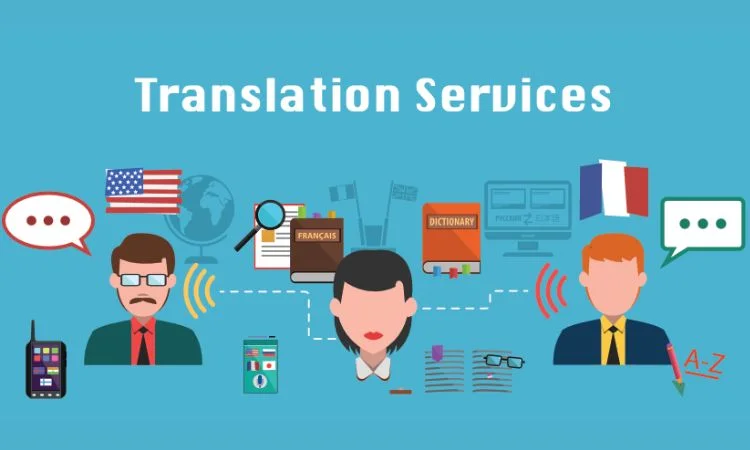In an increasingly interconnected world, businesses are expanding their reach beyond borders, tapping into diverse markets with distinct languages and cultures. In this scenario, translation services have emerged as a critical component of effective marketing strategies. They enable businesses to bridge linguistic and cultural gaps, ensuring that their messages resonate with local audiences. This article explores the significance of translation services in marketing strategies and provides insights into their implementation.
What are translating services?

Translating services refers to professional services for individuals or businesses to convert business or spoken language from one to another. These services are performed by translators who are proficient in the source language (the original language of the content) and the target language (the language to be translated). The goal of a translation service is to ensure that important content is readable and effective in the language while conveying the meaning, tone, and purpose.
Some of the key features of translating services are
1. Accuracy: Translators strive to maintain the accuracy and integrity of the original content while adapting it to the target language and culture.
2. Cultural Sensitivity: Translators take into account cultural nuances, idioms, and customs to ensure that the translated content resonates with the intended audience.
3. Localization: Beyond translation, localization involves adapting content to suit the cultural preferences and norms of the target audience, which can include modifying images, references, and other elements.
4. Subject Matter Expertise: Some translating services require specialized knowledge in fields such as law, medicine, technology, finance, and more to accurately translate terminology and concepts.
5. Interpretation: In addition to written translation, translating services can also include interpretation for spoken communication, whether in person, over the phone, or via video conferencing.
6. Machine Translation and Technology: With advancements in technology, machine translation (using algorithms and artificial intelligence) has become more prevalent. However, human translators are often preferred for complex, nuanced, or sensitive content to ensure accuracy and cultural understanding.
Translating services encompasses a wide ray of facilities to fulfill the diverse needs of people. It includes :
a. Document Translation: This involves translating written documents, such as contracts, legal agreements, certificates, reports, academic papers, and more, from one language to another while maintaining accuracy and preserving the intended meaning.
b. Website Translation: Adapting website content to multiple languages is essential for businesses aiming to reach an international audience. Website translation includes not only the text but also the navigation, user interface, and other elements for a seamless user experience.
c. Marketing Translation: Businesses often require translation of marketing materials, such as advertisements, brochures, social media content, press releases, and product descriptions. Marketing translation involves capturing the brand’s voice and message while making it culturally relevant to the target audience.
d. Technical translation: It refers to the translation of technical documents like engineering equipment manuals, machine manuals, etc. They often require specialized translation to accurately convey complex concepts and terminology.
e. Legal Translation: Legal documents, contracts, court transcripts, patents, and other legal materials require precise translation to maintain legal validity and avoid misinterpretation.
f. Medical Translation: Medical records, research papers, clinical trials, and pharmaceutical documents need precise translation to ensure accurate communication within the medical and healthcare fields.
g. Financial Translation: Financial reports, statements, investor communications, and banking documents require specialized translation to accurately convey financial terminology and concepts.
h. Literary Translation: Translating literature, including novels, poetry, and creative writing, demands capturing the author’s style, tone, and intent while making it resonate with readers of the target language.
i. Interpreting Services: Interpreting involves facilitating spoken communication between parties who speak different languages. There are different modes of interpreting, including simultaneous interpretation, consecutive interpretation, and whispered interpretation.
j. Subtitling and Captioning: Translating spoken content into written form for videos, films, presentations, and online content through subtitling and captioning services.
k. Localization: Beyond translation, localization involves adapting content to the cultural preferences, customs, and idiomatic expressions of the target audience. This includes modifying images, symbols, and references to align with local norms.
l. Software and App Localization: Adapting software interfaces, applications, and video games to different languages and cultures to provide a user-friendly experience.
m. Multilingual SEO: Optimizing website content for search engines in multiple languages to improve visibility and search rankings across various markets.
n. Transcreation: Combining translation and creative writing, transcreation involves adapting marketing content while maintaining the original intent, emotional impact, and cultural resonance.
o. Machine Translation Post-Editing: Reviewing and editing content produced by machine translation to ensure accuracy, fluency, and cultural appropriateness.
With the advent of globalization, the world has turned into a global village. Hence, corporates in the world have to imbibe translating services into their marketing strategies. This will benefit in the following ways.
Recognizing the Significance of Linguistic Diversity
The world of business is a tapestry woven with languages and cultures. To establish connections, with customers it is crucial to speak their language in a literal and figurative sense. This entails more, than translating marketing materials; it involves crafting messages that genuinely resonate with the subtleties and values of the intended audience. Companies that overlook the value of diversity run the risk of alienating customers and forfeiting profitable prospects.
Localization and Translation
Translation involves the conversion of text from one language to another, while localization goes one step further. Localization ensures that the content is unique to the audience by adapting it to their culture, social and linguistic context. This includes changing the visuals, colors, characters and even humor to suit local audiences. By hiring translators and locals, businesses can create a personal and engaging experience for customers.
Improving Brand Perception
Consistency is a cornerstone of effective branding. When a brand is consistent in its messaging across different languages and cultures, it establishes credibility and trust. Translating services help maintain this consistency, ensuring that the brand’s values and promises are accurately conveyed regardless of the language used. This, in turn, fosters a positive brand perception and strengthens the emotional connection between the brand and its diverse customer base.
Expanding Market Reach
The ability to effectively communicate with customers in their native languages opens doors to new markets and opportunities. Translating marketing materials enables businesses to tap into previously untapped markets, effectively increasing their reach. This expansion can lead to higher revenues, improved market share, and enhanced competitiveness on a global scale.
Tailoring Content for Local Relevance
Marketing strategies that work well in one country may not yield the same results in another due to cultural differences. Translating services empower businesses to create content that is not only linguistically accurate but also culturally relevant. By understanding local customs, traditions, and trends,
companies can modify their marketing approach to better resonate with local audiences, driving higher engagement and conversion rates.
Boosting presence and online visibility
Boosting your presence and visibility is crucial, in today’s era. Search engine optimization (SEO) plays a role in achieving this objective. By translating your website content into languages you can enhance your search engine rankings in regions making it more likely, for local audiences to discover your brand. As a result, you’ll attract traffic and increase brand visibility. This in turn enables customers from backgrounds to better understand your products or services engage with your website and ultimately become loyal customers.
How to improve marketing strategy through translation services
Translation services as a part of marketing strategy have expanded their horizons from just conversion of text. It is more about thoughtfully and strategically ensuring that the message resonates with cultural and linguistic audiences. This can be done in the following ways
A. Understand Your Target Audience:
Identify the markets you want to target and understand their cultural preferences, behaviors, and values. Research local trends, customs, and linguistic nuances to tailor your messaging effectively.
B. Translate and Localize Content:
Utilize translating services to accurately translate your marketing materials into the target language. Go beyond translation and adapt content to suit the local culture through localization.
C. Maintain Brand Consistency:
Ensure that your brand’s core values, messaging, and identity remain consistent across all translated content. Work with experienced translators who can convey your brand’s essence in the target language.
D. Adapt Visuals and Imagery:
Modify images, symbols, and visual elements to be culturally relevant and sensitive. Ensure that visuals align with the preferences of the local audience.
E. Tailor messaging for cultural relevance
Every country has its cultural relevance, traditional significance, and deep rooted ideology. Hence, phrases, sentences, and expressions should be tailored keeping in mind the above-mentioned aspects.
F. Optimize for Search Engine Optimization
Search Engine Optimization essentially revolves around entering keywords into content to position products at a higher sequential position. Every country has a different set of keywords, hashtags, etc. Hence, while translating the content, creators should conduct comprehensive research on keywords to be added for better search engine optimization.
G. Test and Iterate
A/B test your translated content to determine which messages, visuals, and strategies perform best in each market. Continuously monitor and analyze the results to refine your approach.
H. Engage native speakers
Work with native speakers to review translations and provide feedback. Native speakers can help identify cultural differences and be authentic.
I. Consider Multilingual Social Media
Establish social media profiles in the languages of your target markets. Share culturally relevant content and engage with followers in their preferred language.
J. Localize User Experience:
If applicable, ensure that your website and app interfaces are user-friendly in the target language. Provide customer support in the local language to enhance the user experience.
Translating tools to be used for effective marketing strategy
1. Linguee
This unique and popular translation tool includes a dictionary and a search engine so you can search both languages and words and phrases
in different languages to determine the meaning and meaning of the word. Linguee can also search the web for relevant translation information and show you how words are translated on the internet. It is often used in conjunction with Google Images to assist translators and language learners.
2. SDL Trados Studio
SDL Trados is Gengo Wordsmiths’ top recommended computer-aided translation (CAT) tool and a smart investment for full-time translators. The software includes TM, terminology, machine translation, and software localization features. Most large organizations require translators to use all CAT tools; therefore using SDL Trados can increase your customer base and broaden your horizons. If you need time to decide before you buy, try the free 30-day demo.
3. Free Dictionary
This website is a multilingual online dictionary, thesaurus, and encyclopedia. Free medical, financial, and legal dictionaries, many idioms, abbreviations, quotes, and non-English languages such as Spanish, French, Portuguese, and Japanese. The encyclopedia also regularly updates some sections to present users with the word or phrase of the day. The free mobile app is compatible with iOS and Android devices.
4. Fluency Now
Fluency Now Professional is an advanced CAT tool and translation memory software designed specifically for freelancers. It costs $9.95 per month and is compatible with Mac, Windows, and Linux operating systems. Fluency Now Enterprise provides organizations with access to additional functionality such as Fluency Flow project management. It also includes project documentation and project statistics.
5. Google translate
Google Translate is a free translation software by Google. It can translate any text into 133 languages. Over 300 million people can speak these languages.
Conclusion
Translating services can be an effective tool to market products in different regions of the world. Many multinational corporations like Audi, BMW, Hermes, etc. have used it to establish a niche market in complex consumer markets like India. However, it can also result in a loss of market share and a negative outlook if not used properly. Therefore, proper research shall be undertaken before using any translating services.














